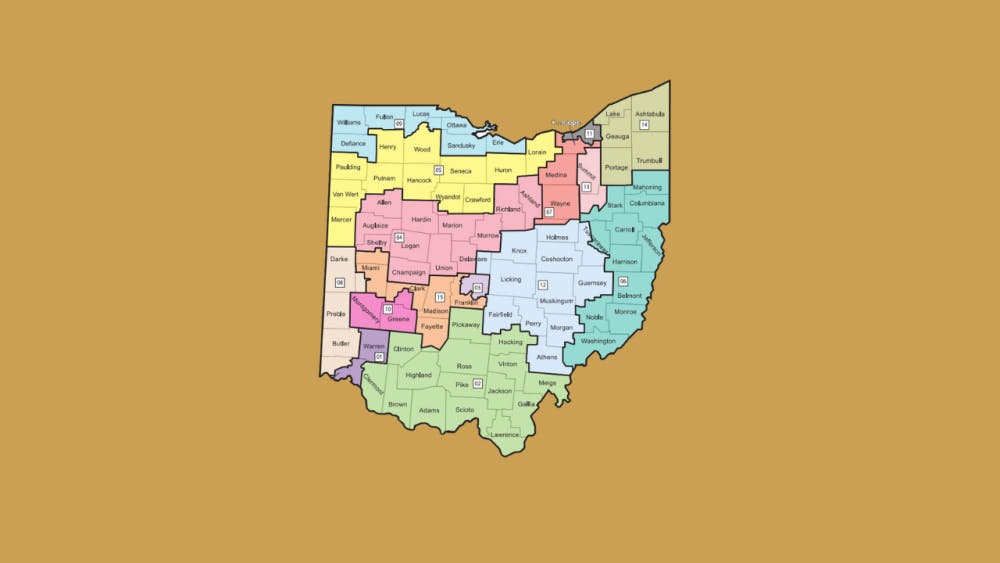Ohio Districts | The Wright State Guardian
One of the most important issues on the ballot this November is Issue One, which aims to end gerrymandering and create a small committee of citizens to ensure voter maps are created fairly. It is important for voters to know the exact language of the Issue and what effects it will have when choosing how to vote.
What is Issue One?
Issue One aims to change the way district voting maps in Ohio are made. If it passes, Issue one will make partisan voter maps a thing of the past.
Currently, elected politicians make the map for voting and it is approved or denied by the Ohio Congress.
If Issue One is approved, a small committee of Citizens from across the state and political spectrums will be created to ensure a fair and equal voter map.
What is gerrymandering?

Every ten years, states are required to draw new maps based on census data for elections. This is to paint a more accurate picture of the state’s population.
But in this process, there have been several instances of politicians changing the map around to favor their parties. This is called gerrymandering and it is a violation of the Voter Rights Act.
Ohio has had issues with gerrymandering in the past. In fact, the Ohio Supreme Court has ruled seven times that voting district maps were unconstitutional.
In 2022, it took redrawing the map five times before there was one that was accepted. The fifth constitution map was not approved until way after the deadline in Oct. of 2023. This left voters to use an older map during the 2022 legislative elections.
Voting Yes
The official Issue Report provides arguments for and against Issue One.
Issue one will ban politicians and lobbyists from the map making process and make it illegal to gerrymander voting districts.
Issue one will “create the 15-member Ohio Citizens Redistricting Commission made up of
Democratic, Republican, and Independent citizens who broadly represent the different geographic areas and demographics of the state,” the Issue Report states.
It will ban politicians, political party officials and lobbyists from sitting on the Commission and require the Commission to operate under an open and independent process.
As well as, “Require fair and impartial districts by making it unconstitutional to draw voting districts that discriminate against or favor any political party or individual politician,” the Issue Report states.
Issue One is supported by a wide variety of Ohioans from both sides of the aisle and more than 100 organizations have endorsed it. One of those is Citizens Not Politicians, a bipartisan and well-funded campaign who began the movement in Ohio.
Citizens Not Politicians spokesperson Chris Davey says that voting yes on this will stop gerrymandering and give citizens power in what happens to our government.
“We want to take politicians out of the process, they have clearly shown that they aren’t capable of creating fair voting maps, so it is our turn,” Davey stated.
Voting No
Proponents of voting no argue that Issue One does the exact opposite of what it says it will.
“Issue 1 is a cynical attempt to trick Ohio voters by promising to end gerrymandering and empower citizens when in fact the amendment forces gerrymandering in the Ohio constitution and removes accountability to Ohio voters,” the Issue Report states.
Some of their issues with the measure include commission members are not required to meet any minimum level of qualifications and Ohio voters cannot remove a commission member if they commit a felony, giving these members unchecked power.
Garth Kant, senior press secretary of the Ohio Senate Majority Caucus and the editor of On The Record, weighs in on Issue one and behind Citizens Not Politicians.
“The proposal is actually a Trojan Horse plan to “fix” our redistricting laws for drawing Congressional and Statehouse maps by replacing an amendment voters overwhelmingly approved in 2015 with an exceedingly complex, harebrained, and radical scheme,” Kant wrote.
While both sides provide strict arguments as to why Ohioans should vote with them, it is ultimately up to the people to decide which way they want to go.
Student opinion
Students' opinions on Issue One were generally for it. Some embraced the change and thought that it would bring about fair elections. Carina Adams, an art major, is one of these students.
“Gerrymandering affects people of color the most. If you look back in history, that is one of the main reasons for it. I'm happy that there is a proposal for change. I will definitely be voting yes,” Adams said.
Others were confused on what Issue One entailed, but ultimately plan to vote for it as well.
To learn more about Issue One, students can read the official state Issue Report and contact Citizens Not Politicians.











